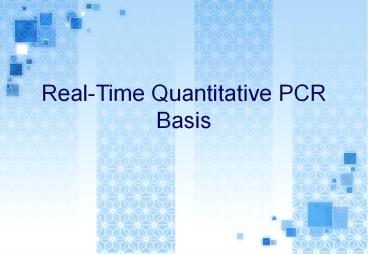Real-Time Quantitative PCR Basis - PowerPoint PPT Presentation
Title:
Real-Time Quantitative PCR Basis
Description:
Basis ABI Prism 7900HT real-time PCR instrument Content Principles of quantification Methods of quantification Applications The polymerase chain reaction (PCR) has ... – PowerPoint PPT presentation
Number of Views:296
Avg rating:3.0/5.0
Title: Real-Time Quantitative PCR Basis
1
Real-Time Quantitative PCRBasis
2
ABI Prism 7900HT real-time PCR instrument
3
Content
- Principles of quantification
- Methods of quantification
- Applications
4
- The polymerase chain reaction (PCR) has
revolutionized the detection of DNA and RNA. As
little as a single copy of a particular sequence
can be specifically amplified and detected. - Theoretically, there is a quantitative
relationship between amount of starting target
sequence and amount of PCR product at any given
cycle. In practice, though, it is a common
experience for replicate reactions to yield
different amounts of PCR product. - The development of real-time quantitative PCR has
eliminated the variability traditionally
associated with quantitative PCR, thus allowing
the routine and reliable quantitation of PCR
products.
5
PCR Reaction Phase
6
Quantification in Log Phase
- Initial template ,more significant
- Perfect reproducibility, less error
- Constant amplification efficiency, linear
standard curve
7
Several Basic Concepts
- Threshold The low limit when PCR reaction signal
goes into log phase - Ct value The cycle number of PCR reaction when
the fluorescence signal reaches to threshold
8
Standard Curve
- CT -k lgX0 b
- There is a linear relationship between CT and
lgX0 (X0 stands for amount of initial DNA) - Use standard sample which we have known its
initial concentration to make standard curve. And
then we can identify the initial concentration of
unknown template through the standard curve when
we obtain its CT value.
9
Methods of quantification
- Dye method
- SYBR Green I
- Probe methods
- TaqMan Probe and TaqMan MGB Probe
- Molecular beacons
- Dual-oligo FRET pairs
10
SYBR Green I
- SYBR Green I dye is a highly specific
double-stranded DNA binding dye. Its fluorescence
increases when it bound to double-stranded DNA
while disappears when DNA denatured. - There is a direct ratio between fluorescence
signal and the amount of double-stranded DNA.
11
Advantages and Disadvantages about SYBR Green I
- SYBR Green I assay chemistry will detect all
double-stranded DNA, including non-specific
reaction products. - The advantage of SYBR Green I assay chemistry
is that no probe is required, thus reducing
assay setup and running costs. And it can make
dissociation curve analysis.
12
Fluorescent Resonant Energy Transfer
(FRET)
- When the emission band of one fluorophore is
overlapped with the absorption band of another,
and simultaneously they are very near , then the
energy will transfer from short wavelength (high
energy) fluorophore to the longer wavelength
(lower energy ) one. In other words, the
fluorescence of short wavelength fluorophore is
quenched by another.
13
TaqMan Probe
- One probe, two primers.
- One probe, two fluorophores one is reporter,
another is quencher . - Hybridises with the target amplicon?
- Is 3 terminally blocked (cannot be extended by
the polymerase)? - Has two fluorescent dyes attached
- 1.Reporter(R)
- 2.Quencher(Q)
14
React Process
15
- The production of one DNA strand will cut one
probe into pieces simultaneously. - The disjunction of one probe will produce one
fluorescent signal. - Signal intensity are proportional to the amount
of DNA which is binded by probe.
16
Advantages about TaqMan chemistry
- Noiseless data
- Due to the second level of specificity
provided by the probe. - Multiplex compatible
- Each probe can be differently colored and
thereby mixed with others. - Signal proportional to products
- Signal related to amount of amplified product
. - Unreversible reaction, signal will not quenched
- Other probe chemistries use reversible
hybridisation to generate signal.
17
TaqMan MGB Probe
- Non background fluorescence
- All probes will be short(13-20bp)
- Tm enhancer MGB
- Minor Groove Binder attached at 3' end of probe
18
SNP Discrimination (Allele Discrimination
)
19
Result
- Homozygote
- wild type FAM
- mutant type VIC
- Heterozygote
- FAMVIC
20
Other Methods Based on Probe
- Molecular beacons
- Dual-oligo FRET pairs
21
Applications Primer and Probe Design Using
Primer Express Software
- Primer Express software uses a set of default
parameters to automatically select primer and
probe sets. - Even though no probe is required for SYBR Green
I dye detection, it is still a good idea to use
Primer Express software to select a primer and
probe set when designing a SYBR Green I assay.
Although no probe will be used, the primers will
meet all the required criteria and if, in the
future, there is the need to convert the assay to
TaqMan assay chemistry to obtain higher
specificity, the probe can immediately be found
in the original Primer Express software
document.
22
Primer and Probes selection guidelines for
quantitative assays
23
(No Transcript)
24
Applications
- Absolute Quantification (AQ)
- Absolute--produces data with quantity amounts
- The absolute quantity of target gene is measured
- needs a standard template whose concentration is
known absolutely - The quantity of the standard template has to be
measured precisely - unnecessary for most studies
25
Applications
- Relative Quantification (RQ)
- Relative--makes comparisons of quantity (no
units) - relative standard curve or ??CT analysis
- any stock DNA or RNA containing the target gene
can be used to prepare relative standard curve - normalises for amount of sample added
- needs endogenous control target
- the most powerful and widely used method
26
Applications
- Allelic Discrimination (AD)
- Plus/Minus with IPC (/-)
27
(No Transcript)
28
(No Transcript)
29
(No Transcript)
30
(No Transcript)
31
(No Transcript)
32
(No Transcript)
33
THANKS!































